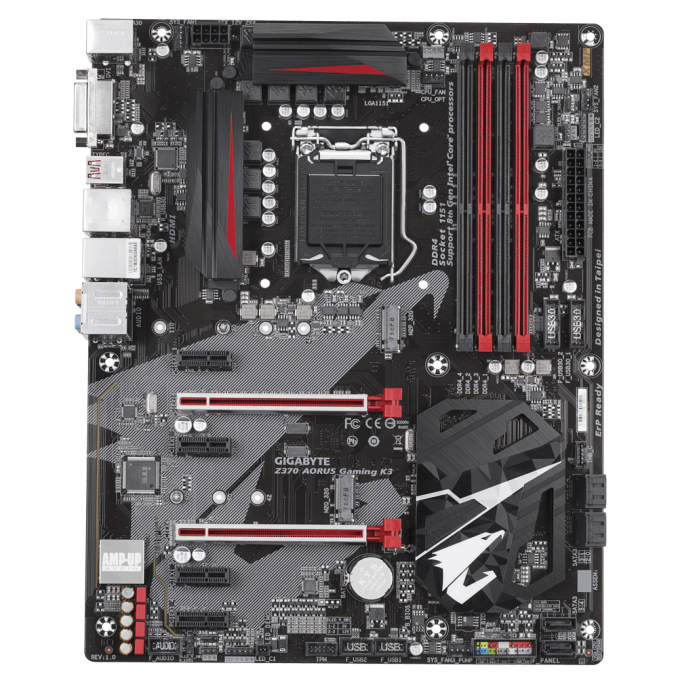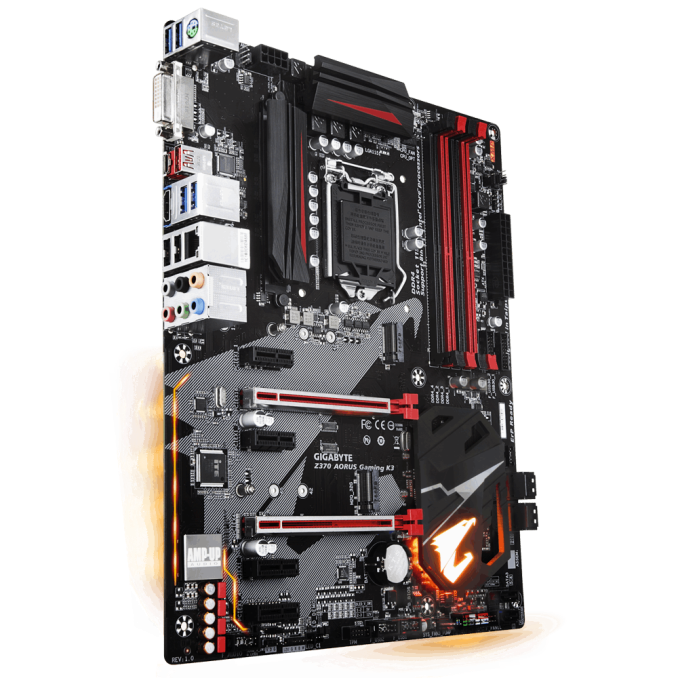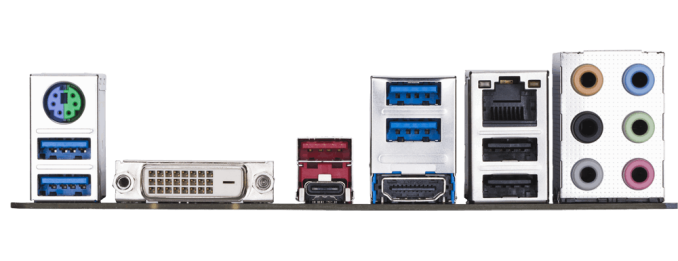Analyzing Z370 for Intel's 8th Generation Coffee Lake: A Quick Look at 50+ Motherboards
by Ian Cutress, Anton Shilov, Joe Shields & Gavin Bonshor on October 20, 2017 2:00 PM ESTGIGABYTE Z370 Gaming K3
The Z370 AORUS Gaming K3 motherboard fits in towards the bottom of the Gaming motherboards but has many of the features users need to be a solid gaming motherboard. Gone is the Killer E2500 NIC and replaced with an Intel I219-V chip. The back panel I/O adds a DVI output for onboard video connection but removes the OC button found on the Gaming 3. RGB Fusion support is still here along with RGBW headers, as well as keeping two M.2 slots.
Between the Gaming 3 and K3 there are few design changes between them. The black PCB and Falcon make its appearance along with the four DIMM slots alternating red and black. The biggest design difference between the two is the lack of a shroud to cover the I/O area. This is a small cost saving measure at the expense of a clean look around back panel IO as well as the RGB LEDs being relegated to the audio separation line and the PCH heatsink. Additional RGB LED strips can be added using any of the four headers (2 RGBW, two digital) all controlled by the RGB Fusion software.
The four memory slots and DDR4-4000 memory support matches the Gaming 3, and a capacity of up to 64GB is supported. The PCIe slot configuration is also the same as the Gaming 3, with four PCIe 1x slots fed from the chipset, and two full length, fortified slots running at x16/x4 with the x4 coming from the chipset. We again see Crossfire support, but not NVIDIA SLI.
The board has six SATA ports, with four located to the right of the PCH heatsink, and two facing vertically just below it and to the right of the front panel headers. The two M.2 slots are also in the same location as the Gaming 3 and support the same size drives. These are located just above the top PCIe 1x slot and just above the bottom full-length PCIe slot. Onboard audio is still handled by the Realtek ALC1220 codec, is shielded for EMI, has audio separation from the rest of the board, and uses the WIMA and Nichicon audio caps. In a cost-saving measure, the board uses an Intel-based NIC instead of the Killer Networks E2500 found on the Gaming 3. WiFi is not found on this board either. Thunderbolt 3 support is handled with an add-in card as well.
USB connectivity is a bit different here, at least on the USB 3.1 (5 Gbps) side. There are a total of eight possible USB 3.1 (5 Gbps) ports from four on the back panel and four available through internal USB headers. For USB2.0/1.1 there are six in total with two ports on the back panel and 4 ports available through the internal USB headers. The ASMedia 3142 controller handles the USB 3.1 (10 Gbps) Type-C and Type-A(red) ports found on the back panel. The back panel IO has a single PS/2 port, removes the OC button, and adds a DVI port. The audio stack does not have SPDIF.
The Z370 AORUS Gaming K3 has a few cost-saving measures compared to the Gaming 3 such as swapping the Killer NIC for Intel, and removing the back panel IO shroud, and secures its place a bit lower in the product stack. While fully featured, the lack of SLI support will have those with multiple NVIDIA GPUs looking at other products in the stack for the necessary support.













83 Comments
View All Comments
Aichon - Friday, October 20, 2017 - link
Love this writeup. Thank you guys so much for putting it together so that we can make sense of the choices.peevee - Friday, October 20, 2017 - link
"These motherboards range from $110 "AM4 MBs start from $40 on newegg. Yet another way AMD provides better value.
DigitalFreak - Friday, October 20, 2017 - link
You want a cookie or something?cap87 - Saturday, October 21, 2017 - link
Nobody cares, this a Z370 article. Go back to your cave with the rest of you AMD buddies.imaheadcase - Saturday, October 21, 2017 - link
Apples to oranges.IGTrading - Sunday, October 22, 2017 - link
Very good comment. Not everybody is going to buy a 8700K and thr cheaper CPUs don't really make sense in a 150 USD motherboard.Also, because Intel doesn't guarantee the Boos frequencies anymore, you don't really know what you're going to get with a 8400 for example.
This was very well exemplified here: https://youtu.be/O98qP-FsIWo
psychocipher - Sunday, October 22, 2017 - link
Theres a difference between value and quality. better quality with more features tend to cost more. Dont hate cause amd doesnt get motherboards like the apex. If zen+ increases clock speeds and increases overclocks to where intel is yall will be wishing you didnt buy a cheap $40 b350 motherboard. Yeah you get to keep your cheap b350 motherboard for zen+ but yeah lets buy a new cpu cause amd is providing better value.OFelix - Friday, October 20, 2017 - link
I haven't read the article yet but I want to say that to make sense of 50+ MBs I'm going to need a comparison system which let's me find all MBs with ThunderBolt for example.Brett Howse - Friday, October 20, 2017 - link
Check the last page.Ian Cutress - Friday, October 20, 2017 - link
+1